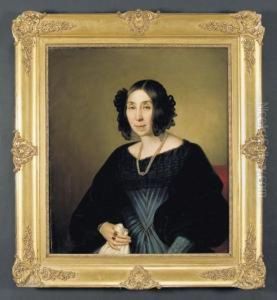Giuseppe Tominz Paintings
Giuseppe Tominz was an Italian painter, primarily known for his portraits and works in the Biedermeier style, which was popular in Central Europe between 1815 and 1848. Tominz was born on July 6, 1790, in Gorizia, which was then part of the Habsburg Monarchy and is now in Italy. He was part of the ethnic Slovene community in the region. His early talent in drawing and painting was evident, and he pursued his education in the arts.
He studied at the Academy of Fine Arts in Vienna under the guidance of Johann Baptist von Lampi the Elder and Johann Baptist von Lampi the Younger, both respected portrait painters of their time. Tominz's style was significantly influenced by his teachers, inheriting a keen sense for realism and detail, which would become characteristic of his own work.
After completing his studies, Tominz returned to his hometown, where he became one of the most sought-after portraitists among the local aristocracy and bourgeoisie. His work was well-regarded for its meticulous attention to the textures of fabrics and the subtle rendering of his subjects' physiognomy. Tominz had the ability to capture not only the likeness but also the character and social status of the individuals he painted.
Tominz's oeuvre consists largely of portraits, but he also produced religious paintings, still lifes, and historical scenes. His portraits often included detailed backgrounds that offer insights into the private lives and environments of his subjects. He was known for his skillful use of chiaroscuro and for his vibrant color palette, which brought his subjects to life.
Throughout his career, Tominz remained active in the cultural life of the region, contributing to the development of the arts not only through his paintings but also through his engagement with local artistic societies. He continued to paint and exhibit his work until his later years.
Giuseppe Tominz died on April 22, 1866, in Gorizia. His legacy as a portraitist is significant, particularly in the regions of modern-day Slovenia and Italy, where his works are still appreciated for their historical value and their contribution to the cultural heritage of the area. His paintings can be found in various museums and galleries, and they continue to be studied by art historians interested in the Biedermeier period and the history of portraiture in the 19th century.





